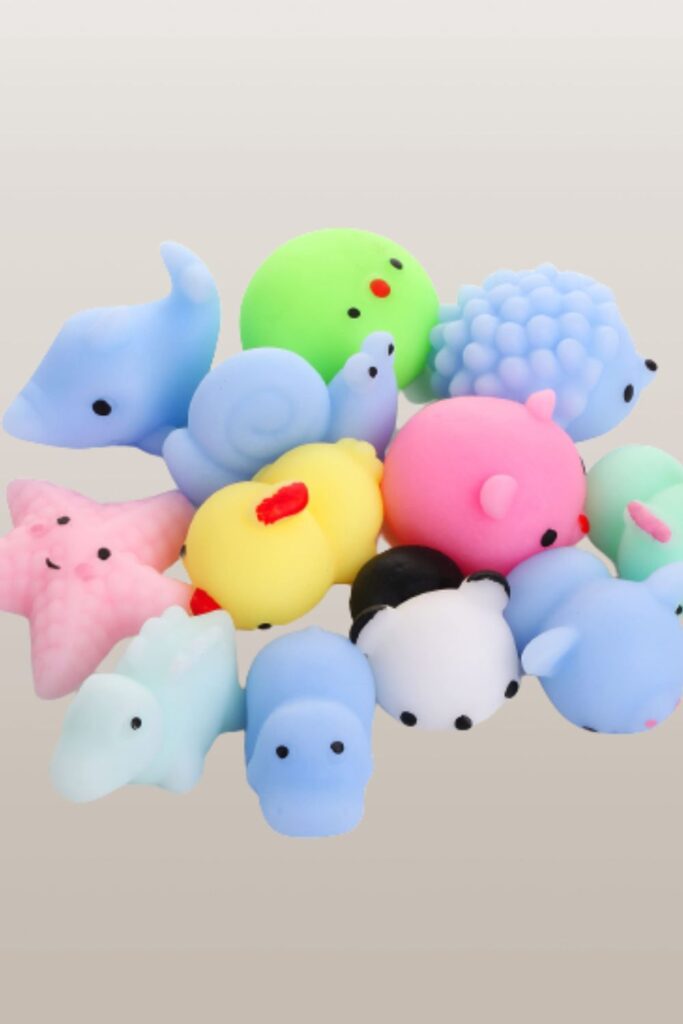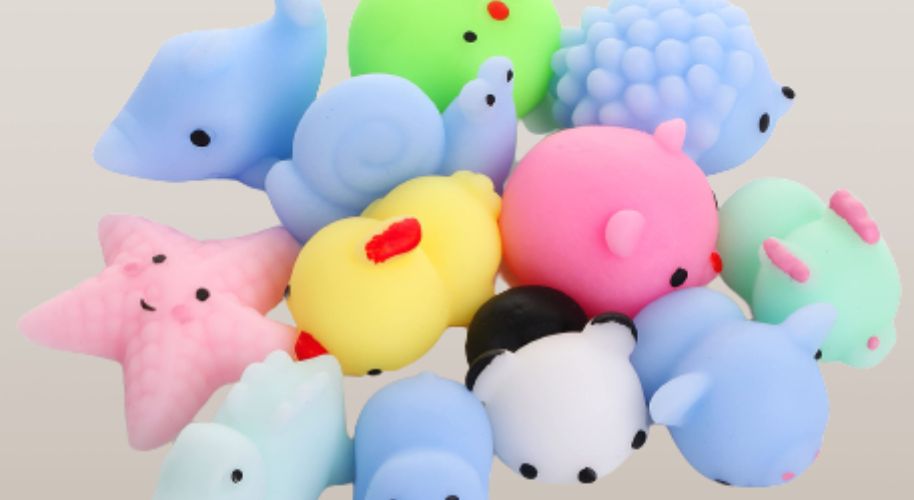Last Updated on June 5, 2025
Squishy toys are a beloved possession for many children (and adults too). Their soft, squeezy texture offers comfort, amusement, and stress relief. However, due to their constant handling, these delightful playthings can quickly become a haven for dirt and grime.
If you’ve been wondering how to restore your squishy toys to their original pristine condition, you’re in the right place! This blog post will be your ultimate guide to cleaning squishy toys. We’ll delve into practical, easy-to-follow steps that cater to every type of squishy toy, from foam squishes to mochi squishy, fidget toys, and more.
We’ll explore different methods, including a damp cloth, soapy water, a washing machine, and baking soda. So, prepare to give your squishy companions the spa day they deserve. Let’s dive in!

Different types of squishy toys
Squishy toys are popular among children and adults due to their tactile and stress-relieving properties. They come in various shapes, sizes, and materials. Here are some different types of squishy toys:
Foam Squishies
These are the most common type of squishy toys. Made from polyurethane foam, they are soft, slow-rising, and often shaped like food, animals, or other cute objects.
Mochi Squishies
Mochi squishes are made from a stretchy, rubbery material similar to mochi desserts. They are smaller than foam squishes and have a unique, satisfying texture.
Fidget Toys
Fidget toys can also be considered a type of squishy toy. Examples include stress balls, sensory rings, and fidget cubes. These toys are designed to help with focus and stress relief.
Plush Squishies
These are a hybrid of plush toys and squishy toys. They have the softness of a plush toy and the squishiness of foam squishies.
DIY Squishies
These are homemade squishy toys. You can use various materials such as sponges, memory foam, or even balloons filled with flour or gel to make them.
Each type of squishy toy offers a unique sensory experience and has its own cleaning and care requirements.
How To Clean Squishy Toys?
Cleaning squishy toys is essential to keep them hygienic and safe for your child. Depending on the material, the cleaning process can vary. Here are step-by-step instructions for cleaning foam, silicone, and fabric-covered squishes.
Foam Squishies
- Fill a basin with warm water and a mild detergent.
- Place the squishy foam in the water and gently squeeze it to absorb the soapy water.
- Let it soak for about 10 minutes.
- Rinse thoroughly under running water, squeezing out the soapy water until it runs clear.
- Allow it to air dry completely before use.
Silicone Squishies
- Wipe the squishy silicone with a cloth dampened with warm soapy water.
- For stubborn stains, use a soft-bristled toothbrush to scrub the surface gently.
- Rinse thoroughly under warm running water.
- Dry the squishy with a clean towel or let it air dry.
Fabric Covered Squishies
- Spot clean using a cloth dipped in mild detergent and warm water.
- Gently blot the stained area until the stain lifts.
- Rinse the area with a cloth dampened with clean water.
- Allow the squishy to air dry. Avoid wringing or twisting the fabric, as this can damage it.
Tips for Removing Stains from Squishy Toys
Removing stains from squishy toys can be tricky, depending on the type of stain and the toy’s material. However, here are some tips gathered from various sources that might help:
Oily Stains
Pineapple juice or fresh pineapple can remove oily stains left by sticky hand toys. Apply it to a rag and gently rub the stain.
General Stains
Wet the stains with clean, cold water. Apply any fabric cleaning spray onto the stains and let it sit for 1-2 minutes. If necessary, use an old toothbrush to scrub the stains.
Stubborn Stains
For particularly stubborn stains, vinegar or bleach can be used. Be sure to test the solution on a small, inconspicuous area first to ensure it doesn’t discolor the toy.
Dirt Particles
If the toys are still dirty, a few tablespoons of distilled white vinegar can be useful to break down stubborn dirt particles.
Marks from Sticky Rubber Toys
Lighter fuel can often work for nasty marks without staining. Alternatively, a 50/50 mix of water and hydrogen peroxide can be sprayed to remove marks left by sticky hand toys.
Baking Soda for Odors and Stains
To remove stubborn stains or odors, baking soda can be used. Mix a small amount of baking soda with water to create a paste. Apply the paste to the stained area.
Always test any cleaning solution on a small, unnoticeable area of the toy first to ensure it won’t damage or discolor the material.
You Might also Like These Resources!
- Removing Crayon Marks from Plastic Toys
- Cleaning Your Bassinet: A Comprehensive Guide
- Maintaining Hygiene: Cleaning a Crib Mattress Thoroughly
When cleaning Squishy toys, what should be considered?

When cleaning squishy toys, several factors should be considered:
Type of Material:
Different materials require different cleaning methods. For example, foam squishes can be soaked in a basin with warm water and mild detergent, while silicone squishes can be cleaned with a damp cloth and mild soap. Fabric-covered squishes are best spot-cleaned to avoid damaging the material.
Presence of Electronic Components:
Toys with built-in battery packs, mechanical parts, or metal should only be spot-cleaned, as water could cause damage.
Frequency of Cleaning:
Regular cleaning is necessary to maintain hygiene. It is recommended to clean squishy toys weekly if they are frequently used.
Avoid Harsh Chemicals:
Harsh chemicals or abrasive scrubbers can damage the squishy material. Instead, opt for mild soap and warm water.
Deep Cleaning:
For a deeper clean, use an old toothbrush and a solution of equal parts rubbing alcohol and water.
Drying:
After cleaning, allow the squishy toy to air dry. Avoid wringing or twisting the fabric, as it can cause damage.
When to Replace Squishy Toys?
Squishy toys, like all other toys, don’t last forever. Over time, they can become worn out or pose a safety risk to your child. Here are a few signs and safety considerations that indicate when it might be time to replace squishy toys:
Signs of Wear and Tear
If a squishy toy shows signs of wear, such as tears, cracks, or peeling, it’s usually time to replace it. These signs not only make the toy less appealing to play with, but they can also create small pieces that could pose a choking hazard.
Change in Texture
If the squishy toy has become hard, stiff, or lost its squishiness, it may no longer be safe or fun for your child to play with.
Discoloration or Stains
Persistent stains or discoloration that cannot be removed even after cleaning may indicate that replacing the toy is time.
Safety Considerations
If any part of the toy has become loose or detached, it should be replaced immediately to prevent choking or other injuries1. Also, if the toy contains batteries or electronic components that are no longer functioning properly, it’s safer to replace it.
Mold Growth
If a squishy toy gets wet and isn’t dried properly, it can develop mold. If you notice any signs of mold, it’s best to replace the toy immediately, as mold can cause health issues.
Odor
If the toy develops a foul or strange odor that doesn’t disappear after cleaning, it might be time to replace it.
Remember, the lifespan of a squishy toy depends on how often it’s used and how well it’s cared for. Regular cleaning and proper storage can help extend the life of your child’s favorite squishy toy.
FAQ Section
Can I put my squishy toy in the washing machine?
Putting squishy toys in the washing machine is generally not recommended, as the agitation can cause them to break apart or lose their shape. However, always check the manufacturer’s cleaning instructions.
How often should I clean my squishy toy?
The frequency of cleaning depends on how often the toy is used. If it’s frequently used, it’s recommended to clean it weekly.
How can I remove odors from my squishy toy?
To remove stubborn odors, you can use baking soda. Mix a small amount of baking soda with water to create a paste, apply it to the area, let it sit, then rinse off.
Conclusion
Cleaning squishy toys is important to maintaining their longevity and ensuring they are safe for children. Mild soap and warm water can take care of most dirt and grime, while stubborn stains may require solutions like rubbing alcohol, baking soda, or even pineapple juice.
Remember to clean these toys regularly, especially if they are frequently used. Weekly cleaning can help prevent the build-up of dirt and bacteria. A paste of baking soda and water can be applied for stubborn stains or odors, then rinsed off. However, always remember to spot-test any cleaning solution on an inconspicuous toy area first to ensure it won’t cause damage or discoloration.
It’s also important to know when to replace squishy toys. Signs of wear and tear, changes in texture, persistent stains, and safety considerations such as loose parts indicate that it might be time for a new toy.
You Might Also Like These Latest Content!
- Installing the Nanit Wall Mount: Step-by-Step Guide
- Maintaining Hygiene: Cleaning a Crib Mattress Thoroughly
- Removing Poop Stains from Your Bathtub

Amy A. Vincent is a Certified Pediatric Sleep Consultant and a mother of three beautiful children. She helps parents transition their babies from swing sleep to safe, independent sleep. She is passionate about helping parents teach their children the skills needed to become good sleepers and aims to make the process as easy and stress-free as possible. Read more
